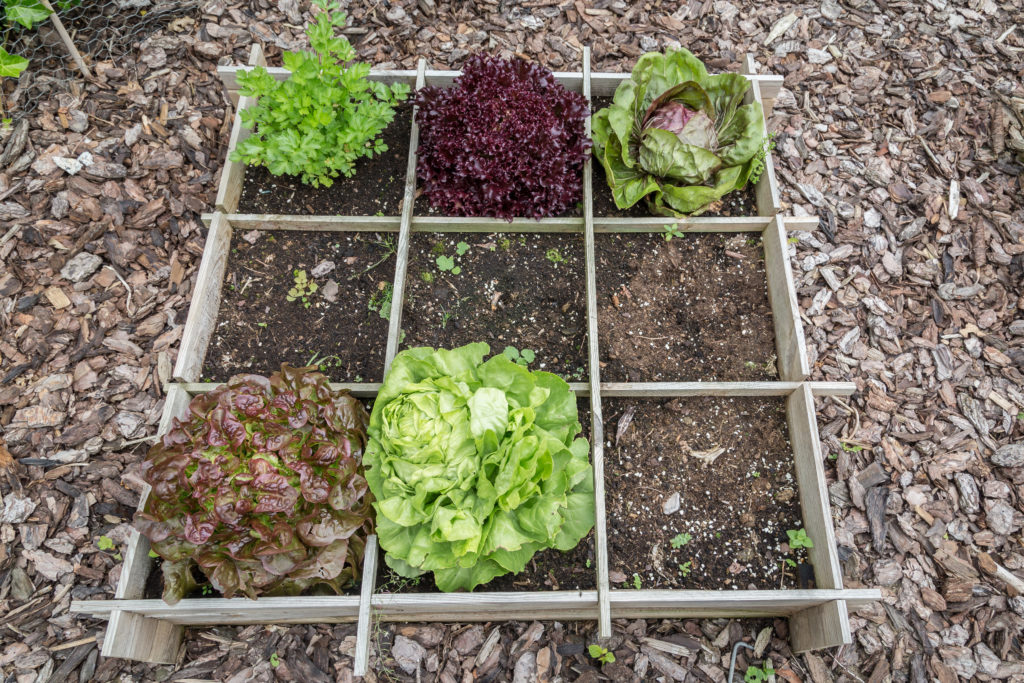A Guide to Square Foot Gardening in Texas
There’s nothing like planning a meal and then heading to your own garden to collect fresh-picked ingredients. But for some people, getting started with gardening can be intimidating. That’s why more and more people are turning to a new and easy entry into the world of vegetable gardening: the square foot garden.
How Square Foot Gardening Works
Instead of planting long rows of crops in a backyard plot, square foot gardening allows you to cultivate vegetables, herbs, and flowers in 1’x1′ square sections, building a grid of plants in elevated beds. This style of gardening produces small quantities quickly and easily, which is why new gardeners often find it so appealing.
The square foot gardening method dates back to author and television presenter Mel Bartholomew, who introduced the method in his 1981 book “Square Foot Gardening.” Bartholomew was a retired engineer who decided to take up gardening. As he plowed his bed and began planting his new crops, Bartholomew saw what he considered redundancies and inefficiencies in the gardening process. The home gardener was spending tons of time weeding massive gaps between rows of plants, and the garden took up a lot of space for the amount of produce it grew. That’s when his retired engineer’s brain went back to work.
Bartholomew developed a method of dividing crops into a grid, planting seeds in a raised bed of deep soil. The approach not only eliminated the amount of time he had to spend weeding but also made it easier to match complementary plants and rotate crops. He put his ideas down in a book which enjoyed such success that it was eventually adapted into a weekly PBS series.
Benefits of Square Foot Gardening
Squeezing a ton of vegetable plants into a relatively small area provides more benefits than simply upping your salad game.
- The proximity of the plants helps create a living mulch, preventing weeds as well as protecting against pests through companion planting.
- Smaller patches of vegetables are easier to maintain, use water efficiently, and can be cared for more simply than a large, rowed garden.
- Coverings to protect plants against birds and the elements can be added around the squares, making it easy to maintain the garden year-round.
- Because plants grow more quickly in square foot gardens, crop rotation is a cinch.

How to Build Your Square Foot Garden
Bartholomew’s method has become so popular that premade garden kits and phone apps can now get you started on your garden. But getting your first crops in the ground is easy enough without any outside help. Here are the four simple steps:
1. Create a raised bed.
The bed should be at least 4’x4′, though you may find starting with a 6’x6′ bed more rewarding.
Create a raised bed over solarized earth, ensuring that your new soil is least 6 inches deep. Initially, Bartholomew’s book suggested a 4’x4′ grid to start out, but it has since been updated to 6’x6′. The truth is, you can make your bed as large or as small as your gardening ambition. You don’t have to make a square garden, either, as long as it divides into 1’x1′ squares; it could be 2’x8′ if you have a narrow length of earth along a fence, for example.
2. Cultivate the perfect soil mix.
Your soil is the secret ingredient to successful square foot gardening. Because the plants are growing in a limited space and are packed close together, the soil needs to be richer and more fertile than regular garden soil to support their growth. Bartholomew recommends supplementing your soil with a mixture of peat, vermiculite, and organic compost. This may be a turnoff to some ecological gardeners, since peat and vermiculite are not renewable resources. The other key to perfect soil: After you lay it down, don’t step on it. Your plants will need well-aerated soil.
3. Plan your squares.
You can plant different crops in each square; the number of plants depends on the spacing the plants need. For example, large plants such as tomatoes and peppers and herbs such as basil and parsley require an entire square per plant. Smaller crops such as carrots and radishes require less space and can fit as many as 16 plants into a single square.
Pick your plants based on what you’d like to grow, how much space each plant requires, and which plants work well together. Here’s where a little research will come in handy. Maybe you’ll choose between adding another square of lettuce or planting marigolds, which are only decorative but also help keep pests off your tomatoes. There are plenty of resources to help you, but ultimately, you’ll want to prioritize whichever plants you think you will eat or use the most.
4. Plant and maintain.
You’ll find that after you get your plants in the ground, they won’t require a ton of upkeep. Some maintenance may include trimming out plants that don’t root well or putting up cages and protective coverings to deal with pests and the elements. DIY plant labels will help add a little flare to your new garden — and help you remember what goes in which square.
Gardening is a magical way to take part in the natural world. Here’s how you can garden to attract birds and butterflies to your yard.
© 2021 Texas Farm Bureau Insurance



